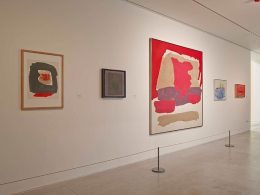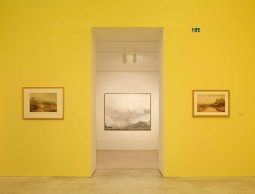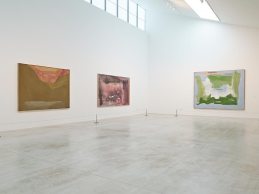It’s been 45 years since anyone in the UK had a chance to view a body of Helen Frankenthaler’s work. So we must thank Turner Contemporary in Margate for providing a long overdue opportunity.
New York’s school of Abstract Expressionism, the air that she breathed, was one of the most powerful tendencies in 20th-century art. Like virtually all of the women in that movement, she has been overshadowed and overlooked.
A creative pairing by Turner scholar James Hamilton transforms what might have been a dry art-historical exercise into a delightful and energising experience.
In his effective juxtaposition, imaginatively hung in the Turner’s airy spaces, one painting in particular stood out – it was sober in shape and composition and far less colourful than many of the others.
It was Frankenthaler’s uncharacteristic, near-monochrome Burnt Norton. Was she thinking of T.S. Eliot’s eponymous poem inspired by an Oxfordshire garden? The glowering mountains certainly don’t make you think of the Cotswolds’ gently rolling plains. Their bulky curves are scarcely differentiated, as a pink sunset modulates the sky. There is a hint of water floating in the foreground, summarised by just a pale line. It is hardly reminiscent of Turner’s deliquescent rendering of distance.
But Eliot’s sense of classicism, his evocation of an eternal moment – his ‘still point of the turning world’ – resonates powerfully, in the work of both artists.
Born some 150 years apart, Turner and Frankenthaler interpreted the natural world around them, whilst pushing the boundaries of what an artist could do with paint. As Hamilton notes, they were fascinated by the possibilities of ‘accidents’ that happen as paint is applied to the canvas. They deliberately engaged in a dialogue with gravity and chance.
Many well-loved Turners here are most familiar, as they are on loan from the Tate and public galleries. But often lifting a painting out of its usual home provides entirely new and fruitful avenues of research and discovery.
And so it is here. When we see Frankenthaler’s sparkling, frothy greys and whites in Barometer (1992) next to Turner’s Stormy Sea Breaking on a Shore (1840–45), the long temporal distance between them seems to shrink. Turner almost appears as the more radical and experimental, while the New York modernist suddenly acquires the patina of an old master. Turner’s delicately wonderful watercolour and gouache, On the Seashore, looks as fresh and abstract as any ‘modern’ work.
But these comparisons are somewhat deceptive. On the Seashore is only 19×27 cm while Frankenthaler tended to work on a grand scale, usually measuring in metres. So large that she used mops, large sponges and decorators’ brushes to push and float her paint and thinners over canvases laid on the floor. (Don’t miss the film about her working process.)

Stormy Sea Breaking on a Shore (1840–5) JMW Turner Yale Center for British Art, Paul Mellon Collection
Frank O’Hara, who in 1960 curated Frankenthaler’s first museum show, wrote about the new American poetry that: ‘It may be…that poetry brings forth the intangible quality of accidents which are all too concrete and circumstantial’.
It is just that sense of poetic alchemy that brings these artists together and makes this exhibition sing.
‘Making Painting: Helen Frankenthaler and JMW Turner’ is at Turner Contemporary until 11 May.
Installation views at Turner Contemporary:




























![Masterpiece [Re]discovery 2022. Photo: Ben Fisher Photography, courtesy of Masterpiece London](http://www.apollo-magazine.com/wp-content/uploads/2022/07/MPL2022_4263.jpg)
Suzanne Valadon’s shifting gaze